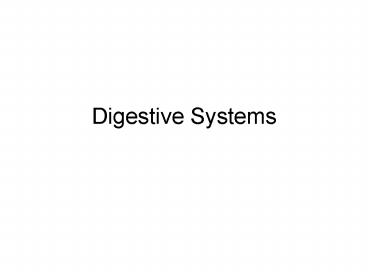Digestive Systems - PowerPoint PPT Presentation
1 / 24
Title:
Digestive Systems
Description:
3. Omnivores both plant and animal eaters pig and humans ... Cloaca urine is combined with feces very high in N. Vent homologous to the anus ... – PowerPoint PPT presentation
Number of Views:27
Avg rating:3.0/5.0
Title: Digestive Systems
1
Digestive Systems
2
3 classes of animals based on Diet
- 1. Carnivores eat meat dogs and cats
- 2. Herbivores eat plants - cattle, horses,
and sheep - 3. Omnivores both plant and animal eaters
pig and humans
3
3 classes of animals based on digestive systems
- Monogastric 1 stomach cant digest cellulose
(fiber) pigs and humans - Ruminant 4 stomachs polygastric digest
cellulose, produce own B vitamins and proteins
cows and sheep - Pseudo-ruminant - have 1 stomach, but have
enlarged cecum that digests cellulose horses
and rabbits
4
Monogastric
5
(No Transcript)
6
Mouth
- Prehension gathering food teeth, lips, tongue
- Mastication Chewing break food into smaller
pieces for swallowing teeth and saliva
7
- Esophagus transport tube to stomach muscular
contractions move food down - Stomach
- conditions pH of 2, churning and contracting to
mix and grind food - ingredients food, HCl, enzymes
8
Small Intestine
- major site of nutrient absorption
- Glands gallbladder secretes bile used for lipid
breakdown Pancreas secretes enzymes for protein
and carbohydrate breakdown - Functions villi absorb nutrients that have been
broken down minerals, vitamins, amino acids,
Fatty acids, simple sugars
9
- Large intestine colon
- accumulates wastes
- absorbs water
- Rectum and Anus
10
Ruminant
11
(No Transcript)
12
- Mouth
- Prehension cow tongue is very long
- Mastication graze rapidly, and dont chew much
1st time - Esophagus liquids to the reticulum and solids
to the rumen - Rumen very large compartment
13
- Regurgitation when rumen full, force contents
back up to re-chew - Rumination
- re-mastication of cud or bolus
- Bolus ball of grass
- Adds saliva to food
- Esophagus re-swallow food
- Reticulum honeycomb
14
Rumen
- fermentation vat
- 30 gal or more
- contains microbes that break down the cellulose
- pH of 6.5 7 for microbes
- releases methane belch
- creates B vitamins and proteins from amino acids
- also contains papalli that absorb nutrients
released by microbes
15
- Omasum filter for large particles grinds them
down - Abomasum like the monogastric stomach acidic
- Small intestine same as monogastric
- Large intestine same as monogastric
- Rectum and anus
16
Pseudo-Ruminant
17
(No Transcript)
18
- Mouth
- a. prehension
- b. mastication
- Esophagus
- Stomach
- a. same as monogastric
- b. too small in horses and inactive doesnt
break down cellulose - c. require frequent smaller meals
19
- Small intestine absorption of nutrients same
as monogastric - Still has not digested the cellulose large
amount - Cecum
- enlarged area between small and large intestine
- contains microbes that break down cellulose like
rumen
20
- Large colon absorbs nutrients released by cecum
- Small colon absorbs water and collects waste
- Rectum and Anus
21
Chicken
22
(No Transcript)
23
- Beak
- Prehension claws
- Mastication - no teeth and no enzymes in the
saliva - Esophagus
- Crop enlargement in esophagus that adds
moisture - Proventriculus adds HCl and enzymes to begin
digestion
24
- Gizzard muscular region that contains grit to
grind food - Small intestine absorbs nutrients through villa
- Ceca bi-lobed region that breaks down and
absorbs cellulose not much in chicken diet - Large intestine very short absorbs water
- Cloaca urine is combined with feces very high
in N - Vent homologous to the anus































